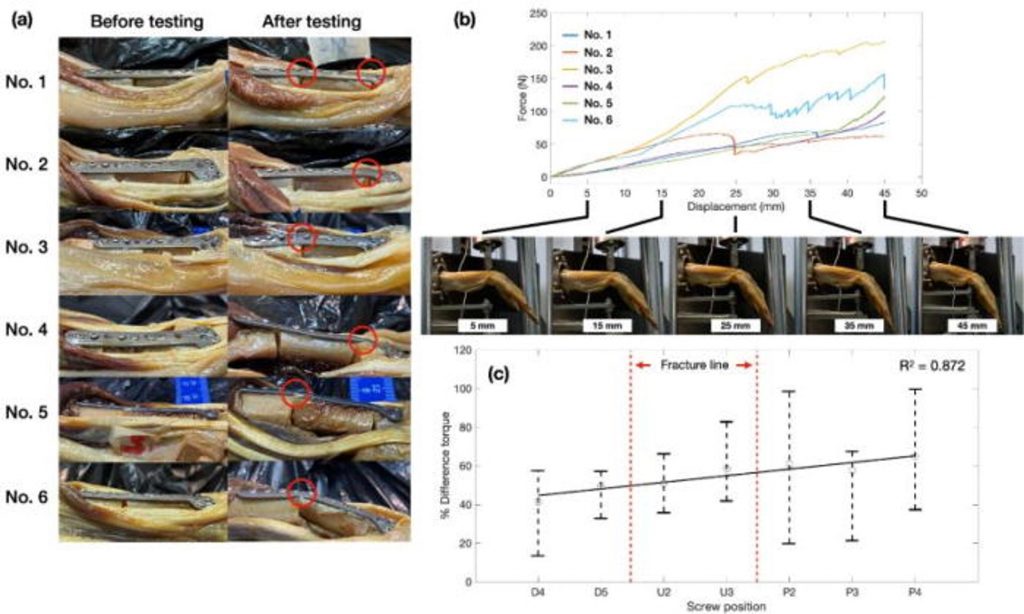Highlight
งานวิจัยนี้ใช้แบบจำลององค์ประกอบจำกัดร่วมกับการทดสอบบนร่าง Thiel เพื่อวิเคราะห์การคลายและหลุดของสกรูในแผ่นเหล็กยึดตรึงกระดูกบริเวณปลายแขน ผลลัพธ์แสดงให้เห็นว่าสกรูใกล้ช่องว่างของกระดูกมีแนวโน้มคลายตัวสูงที่สุด ซึ่งสอดคล้องกับการทดสอบทางคลินิก ช่วยให้แพทย์สามารถวางแผนการผ่าตัดและเลือกสกรูที่เหมาะสมเพื่อลดภาวะแทรกซ้อนได้อย่างมีประสิทธิภาพ

ที่มาและความสำคัญ
ในกรณีของการผ่าตัดบริเวณปลายล่างของกระดูกเรเดียส (distal radius) โดยเฉพาะในผู้ป่วยที่มีเนื้องอกหรือการบาดเจ็บรุนแรง อาจจำเป็นต้องตัดกระดูกออกทั้งหมด (en bloc resection) และใช้กระดูกอัลนา (ulna) มาทดแทนพร้อมการยึดตรึงด้วยแผ่นเหล็ก (plate fixation) ปัญหาสำคัญที่มักพบคือการคลายหรือหลุดของสกรูยึด ซึ่งส่งผลต่อความมั่นคงของการตรึงและผลลัพธ์ของการผ่าตัด งานวิจัยนี้จึงมีจุดมุ่งหมายเพื่อศึกษากลไกการหลุดของสกรูโดยใช้การวิเคราะห์องค์ประกอบจำกัด (finite element analysis) ร่วมกับการทดสอบทางชีวกลศาสตร์ในร่างอาจารย์ใหญ่ที่ดองด้วยวิธี Thiel ซึ่งรักษาสภาพความยืดหยุ่นของเนื้อเยื่อได้ดีและใกล้เคียงสภาพจริงมากกว่าศพแช่แข็ง ผลการศึกษาให้ข้อมูลสำคัญเกี่ยวกับตำแหน่งของสกรูที่มีแนวโน้มคลายตัวภายใต้แรงกดงอ และเสนอแนะแนวทางการวางสกรูและการเลือกใช้สกรูให้เหมาะสมกับตำแหน่งเสี่ยง เพื่อเพิ่มความมั่นคงในการตรึงแผ่นและลดภาวะแทรกซ้อนหลังผ่าตัด
Abstract
Fractures of the distal radius often require surgical intervention, with plate fixation being a standard stabilization method. Screw loosening and pull-out propose significant complications, necessitating comprehensive understanding of fixation stability factors. This study introduces a novel approach by the combination of finite element analysis (FEA) and experimental investigations on Thiel cadavers to evaluate screw pull-out behavior from plate fixation in en bloc distal radius resection with ulnar reconstruction. In comparison with previous investigations that used computational modeling or fresh-frozen cadaveric specimens, in the present research, FEA predictions specifically experimentally confirm the usage of Thiel cadavers, which better preserve soft tissue elasticity and hydration, thus more closely reflect in vivo conditions. Experimental set-up consisted of bending tests on cadavers and screw pull-out tests in Thiel-cadaveric radius specimens mimicking physiological conditions that induce the effects of screw pull-out. Finite element analysis and simulation were conducted using realistic clinical cases. Biomechanical test results indicated locking-plate deformation and screw loosening, particularly at locations closest to the ulnar bone gap. Torque measurements established various degrees of screw loosening, with the screws closest to the bone gap indicating maximum loosening. FEA demonstrated critical distributions of stresses in screws and locking plates, with good correlations to experimental findings. Screw pull-out force analysis showed vulnerability to loosening, particularly in the area of bone gaps, with findings consistent between biomechanical testing and FEA. This study offers valuable information on the surgical implications and biomechanical considerations of plate fixation for en bloc distal radius resection with ulnar reconstruction.
KEYWORDS: Elastic modulus, Poisson’s ratio, Torque measurement, Finite-element analysis, Cancer
Citation: Chancharoen, W., Nwe, T., Seehanam, S., Taradolpisut, N., Berkband, T., Chobpenthai, T., Jongwannasiri, C., & Yurasakpong, L. (2025). Evaluation of screw pull-out from plate fixation of en bloc distal radius resection with ulnar reconstruction: Finite element analysis and comparison with experiments on Thiel cadavers. APL Bioengineering, 9(2), 026123. https://doi.org/10.1063/5.0248553
RELATED SDGs:
3. GOOD HEALTH AND WELL-BEING

ผู้ให้ข้อมูล: ผู้ช่วยศาสตราจารย์ ดร.ลภัสรดา ยุรศักดิ์พงศ์
ชื่ออาจารย์ที่ทำวิจัย: ผู้ช่วยศาสตราจารย์ ดร.ลภัสรดา ยุรศักดิ์พงศ์
ชื่อนักศึกษาที่ทำวิจัย: นางสาวนภาวรรณ ธราดลพิศุทธ์
แหล่งทุนวิจัย: Chulabhorn Royal Academy [Fundamental Fund: the fiscal year 2023 by National Science Research and Innovation Fund (FRB660044/0240 Project code 180847)]
Credit ภาพ: ผู้ช่วยศาสตราจารย์ ดร.ลภัสรดา ยุรศักดิ์พงศ์
Webmaster: ว่าที่ ร.อ. นเรศ จันทรังสิกุล
Tags: Cancer, Elastic modulus, Finite-element analysis, Poisson's ratio, Torque measurement
